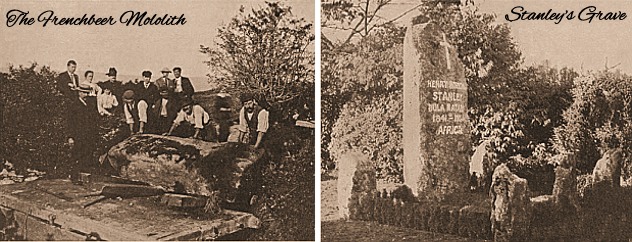
It’s a well known fact that Dartmoor granite is ideally suited for fashioning monuments and gravestones and examples of such can be seen all around the United Kingdom. In the churchyard of St. Michael and All Angels at Pirbright stands a huge monolith of Dartmoor granite. This marks the grave of Henry Morton Stanley the famous African explorer who died on the 10th of May 1904. Whilst he was in the Congo he worked alongside the labourers who were breaking rocks in order to build the first modern road alongside the river Congo. Because of this the locals called him – ‘Bula Matari’ which meant the ‘Breaker of Stones’ or ‘Breakstones’. Following Stanley’s death his wife, Lady Stanley, expressed a wish that she wanted a great monolith the mark his grave. It was her desire that it be; “fashioned by the ages, tempered and coloured by time and untouched by man.” To this end she employed the services of The Art Company of West Norwood to find such a monolith and suggested they went to Dartmoor to search for one. Now follows their account of that search:
“Lady Stanley suggested our searching Dartmoor to find such a stone, indicating the north-east corner as the most likely spot. Moretonhampstead, Chagford, Gidleigh, Wallabrook, Teigncombe, Batworthy, Castor (Kestor), Frenchbeer, Thornworthy, Fernworthy, Hemstone and Grimspound were all explored, and amid thousands of stones few contained all that was essential to such a scheme. The river stones were too rounded, smooth and pudding shaped; those on the moor irregular, and many much too massive: those most likely and most suitable were the most inaccessible, for this wild waste has few tracks and no roads upon which such a load can be conveyed. It became evident that more attention should be given to moorland farms which have roads leading into the border towns. Our mission being explained, the owners and tenants showed the keenest interest, and many were the offers of stones for Stanley’s memorial. After several days thus employed, a large granite monoloith was discovered on Frenchbeer Farm which seemed at once to impress itself as being “the stone,” and upon careful examination it was found to contain all that was essential, its extreme length being 12ft., width 4ft., varying from 2ft. to 2ft. 6in. in thickness. It was in a recumbent position, forming part of a fence on the roadside; three faces had been fully exposed for many years. The owner, Robert Stark, Esq., and the tenant, Mr. George Mortimer, most cheerfully gave their consent to its removal, only stipulating that a brass plate should be fixed to a smaller stone stating that from the spot was removed the stone which now stands at the head of Stanley’s grave. The five smaller stones which form the boundary of this simple enclosure were found in the immediate neighbourhood.

These moorland stones are for the greater part recumbent. The few which stand today were raised as memorials to chieftains: others form circles, huts, and avenues, and remain to us the silent witnesses of a race of whose history we know so little. Whatever their past history may be, it seems fitting that one should be raised in our time to this great African leader. It has now definite work to do, and for ages yet to come will bear the name of that great son to whom the wilds of Dartmoor were as nothing compared with that vast continent which none knew better than he, and whose name will live, not by this memorial, but as one of the great pioneers of Christianity, civilisation, and hope to that dark land.
The removal of these stones from Dartmoor to Pirbright was not a matter of everyday occurrence, and again the Devonshire people showed their interest. As the stone passed through Chagford and other places snapshots were taken as mementos of its progress. The Devonshire roads being steep and difficult, it was found necessary to employ a traction engine and waggon to convey it to the railway at Moretonhampstead. After much labour the great stone weighing six tons, now stands in Pirbright Churchyard, imperishable as the name cut deep on its face.
The words of the inscription were chosen by Lady Stanley. She wrote:”I desire simply his name, Henry Morton Stanley, beneath it his great African name, Bula Matari – The Rock Breaker. For the epitaph, the single word Africa, and above all, the emblem and assurance of life everlasting – the Cross of Christ.” – The Norwood News, October 29th 1904.
As can be seen from the photograph above the five smaller stones from the neighbourhood of Frenchbeer form a small enclosure around the monolith but today there is no sign of the promised brass plaque. It would be interesting to know why Lady Stanley insisted on Dartmoor granite for her husbands grave marker? It is also notable that from the date of Stanley’s death it only took around five months to locate the monolith and transport it all the way to Pirbright in Surrey. Just imagine, having been given such strict criteria as to what the monolith must adhere the miles covered over stream and tor to locate such a thing. It must also have been frustrating to know of the various quarries on Dartmoor that could easily supply what was needed except it would have been touched by human hands.
Today the monument is pretty much the same as it was in 1904 apart from the fact that under Stanley’s epitaph the words -” and his wife – Dorothy – died 6th October 1926,” are now inscribed. Additionally a small granite plaque has been inset into the base of the monolith which read; “Denzil Morton Stanley – 1895 – 1979,” and; “Richard Morton Stanley – 1934 -1986.”
 Legendary Dartmoor The many aspects past and present of Dartmoor
Legendary Dartmoor The many aspects past and present of Dartmoor
